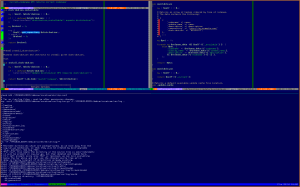Key Takeaways
- Always keep a tmux session on, this helps when you’re in the middle of coding and you forgot to initiate tmux in the first place.
- Use multiple pane synchronization when you need to perform a repetitive operation on multiple machines, tmux simultaneously sends keyboard input from one pane to all others.
- Use the tmux Plugin Manager to install plugins and enhance your tmux experience. For example, tmux-resurrect persists a tmux environment across system restarts, and tmux-continuum continuously saves your tmux environment at regular intervals.
- With tmux you can navigate seamlessly between vim splits and tmux panes using vim-tmux-navigator, and tmuxinator is a great tool to create and manage tmux sessions easily, especially when you have different projects requiring different layouts.

In this article, I bring you ten of my favorite tmux tips. For those unfamiliar with tmux, SitePoint Ruby Editor Glenn Goodrich has written an excellent overview of the basics.
Today, I am going to show you the tips and tricks I use with tmux on a daily basis, as well as how tmux can improve the workflow of your Ruby development. If you are a vim user, you will be in for a treat.
Tip #1: Always Have a tmux Session On
Getting into a new habit is always an uphill battle. Just like trying to force myself into using the hjkl keys in vim by disabling the arrow keys, I needed to find a way to force myself to use tmux all the time. This is useful when you are in the middle of coding and you forgot that you should have tmux-ed in the first place.
The above example works with iTerm2 on Mac OSX. It shouldn’t be difficult to search for Linux equivalents. The main idea is to always run tmux attach -t base || tmux new -s base when the terminal program starts up.
The line above attempts to connect to a previously created session called base, or creates a new one (also called base) if it doesn’t exist. You can rename base to anything you want, it is not a special keyword. With this incantation, whenever you fire up the terminal, you will automatically connect back to your previous tmux session.
Tip #2: Multiple Pane Synchronization
The video above shows four panes loaded with REPLs of four different languages. Going in a clockwise direction, we have Haskell, Ruby, Elixir, and Python. What setw synchronise-panes gives us is that it simultaneously sends keyboard input from one pane to the rest of the panes. (In this case, we can also see the the Elixir REPL is far superior because of the colored output.)
Obviously, this demonstration is a mere party trick to impress developers and nothing more. A good use case is having to perform a repetitive operation on multiple machines. For example, imagine having a tmux session connected to four remote hosts and having to executer the exact same command on all of them.
Tip #3: Refreshing tmux
I am prone to clearing the terminal with Command + L. Unfortunately in tmux, this just messes up the entire session. To illustrate, the above shows my typical tmux experience: I am happily programming when somehow, my fat fingers hit Command+k and my entire tmux session gets messed up, making me mad:
Thankfully, the easy fix is to bind prefix-r to reload the tmux configuration file, and everything is nice again. In ~/.tmux.conf, add the following entry:
bind-key r source-file ~/.tmux.conf
This tells tmux to source the configuration again, essentially reloading tmux.
Tip #4: The tmux Plugin Manager
This is a recent discovery of mine. I didn’t realize someone had created a tmux plugin manager. I won’t bore you with the details of installation, since it is pretty straightforward.
Once you get the plugin installed, it’s only a matter of selecting the plugin you want and pasting the entry into tmux.conf.
If you use Vundle or Pathogen for vim, the process is the same. You declare whatever plugins you want by supplying the GitHub username and repo, save tmux.conf, then hit prefix + I to install the plugin:
The next two tips cover two interesting plugins that can be installed with the tmux plugin manager.
Tip #5: Resurrecting tmux
tmux-resurrect is a tool to persist a tmux environment across system restarts. Why is this useful? When you restart tmux, your entire tmux session is gone. tmux-resurrect fixes that. Another very nice feature of tmux-resurrect is the ability to restore vim sessions too!
In the video that follows, I have a vim session in the left pane rails console and rails server, respectively, on the right.
In order for tmux-resurrect to persist a vim session, install Tim Pope’s vim-obsession. vim-obssesion makes it easier to record a vim session. I haven’t played with it much, but let me show you the entire process:
First of all, we have to tell vim-obsession to track the session. I also have htop running in another window.
In order to save an entire tmux session, type prefix + Control + s. Then if something kills the tmux server, which is what happens when your battery runs out or when someone trips over the wire and the power gets cut. With tmux-resurrect, losing your tmux session is not an issue. In order to restore the session, you need to run tmux again, and this time, hit prefix + Control + r.
However, I can already here some people thinking, “Isn’t manually doing prefix + Control + s + r is a hassle! Who has time to remember all that?” Enter tip #6.
Tip #6: tmux-continuum
tmux-continuum continuously saves your tmux environment at regular intervals and automatically restores it when tmux is started.
Tip #7: Zooming tmux
Zoom was introduced in tmux 1.8. tmux zooming is very useful when you want to look at test failures or inspect logs. To zoom into a pane, hit prefix + z, and use the same combination to zoom out.
Tip #8: Navigate Seamlessly Between vim Splits and tmux Panes
It can sometimes be confusing to figure out whether you are in a vim split or in a tmux pane. Navigating between both is also a hassle. That is until vim-tmux-navigator came along.
Here, we have a tmux session with three panes. The left half consists of two vim splits, and the right hand side contains two tmux panes.
With vim-tmux-navigator, I can navigate across vim splits and tmux panes using Control + hjkl:
Tip #9: vim + tmux + Ruby Specs
vim and tmux make a very nice combination to run Ruby tests. For this to work, you need to install three vim plugins:
Once you have these plugins installed, let’s see how they make our workflow better:
We have the specs for a Micropost model. I have configured to runs all the specs found in this file. However, when I hit , it runs only the specs under the cursor. Extremely handy!
Tip #10: tmuxinator
In addition to having an awesome name, tmuxinator is an excellent Ruby gem that helps you create an manage tmux sessions easily. tmuxinator is especially useful when you have different projects requiring different layouts of panes/windows.
Thanks for Reading!
I hope you enjoyed this article, and learned something new. Do you have other tips to share? Spread some tmux love in the comments below!
Resources
- tmux: Productive Mouse-Free Development by Brian Hogan
- Impressive Ruby Productivity with Vim and Tmux – Ancient City Ruby 2013 by Chris Hunt
Frequently Asked Questions (FAQs) about Tmux
What are the benefits of using Tmux over other terminal multiplexers?
Tmux is a powerful terminal multiplexer that offers several advantages over other similar tools. Firstly, it allows you to run multiple terminal sessions within a single window. This is particularly useful for developers who need to work on multiple tasks simultaneously. Secondly, Tmux sessions are persistent. This means that even if you accidentally close your terminal or lose your SSH connection, you can easily resume your work from where you left off. Lastly, Tmux is highly customizable. You can modify its configuration file to suit your specific needs and preferences.
How can I customize my Tmux configuration?
Tmux allows you to customize its behavior through a configuration file located at ~/.tmux.conf. You can modify this file to change various settings such as the key bindings, status line, color scheme, and more. For instance, you can change the prefix key from the default ‘Ctrl-b’ to something else like ‘Ctrl-a’. You can also set the default terminal size, enable mouse support, and customize the status line to display useful information such as the current time, date, and hostname.
How can I manage Tmux sessions, windows, and panes?
Tmux provides several commands to manage sessions, windows, and panes. You can create a new session using the ‘tmux new-session’ command or simply ‘tmux’. To detach from a session, you can use the ‘tmux detach’ command or the ‘Ctrl-b d’ key binding. To switch between sessions, you can use the ‘tmux switch-session’ command or the ‘Ctrl-b l’ key binding. Similarly, you can create, close, and navigate between windows and panes using various Tmux commands and key bindings.
How can I share a Tmux session with another user?
Tmux allows you to share sessions with other users, which can be useful for pair programming or collaborative debugging. To share a session, you need to create a new Tmux session and then change its permissions so that the other user can access it. The other user can then attach to the shared session using the ‘tmux attach-session’ command.
How can I save and restore Tmux sessions?
While Tmux sessions are persistent by default, they do not survive a system reboot. However, you can use a plugin like Tmux Resurrect to save and restore your Tmux sessions. This plugin allows you to save your current Tmux environment, including the sessions, windows, panes, and even the command history, to a file. You can then restore your Tmux environment from this file after a system reboot or whenever you need it.
How can I use Tmux for remote pair programming?
Tmux is a great tool for remote pair programming. You can create a Tmux session on a server and then share it with your pair programming partner. Both of you can then work on the same codebase in real-time, with each of you having the ability to write and execute code. This can greatly enhance your productivity and make the pair programming experience much more enjoyable.
How can I copy and paste text in Tmux?
Tmux provides a built-in copy-paste mechanism. You can enter the copy mode using the ‘Ctrl-b [‘ key binding, then navigate to the text you want to copy, and start the selection using the ‘Space’ key. After selecting the text, you can copy it using the ‘Enter’ key. To paste the copied text, you can use the ‘Ctrl-b ]’ key binding.
How can I split the terminal window into multiple panes in Tmux?
Tmux allows you to split your terminal window into multiple panes, either horizontally or vertically. You can create a horizontal split using the ‘Ctrl-b %’ key binding and a vertical split using the ‘Ctrl-b “‘ key binding. You can then navigate between the panes using the ‘Ctrl-b ArrowKey’ key bindings.
How can I resize panes in Tmux?
You can resize panes in Tmux using the ‘Ctrl-b Ctrl-ArrowKey’ key bindings. For instance, you can increase the size of a pane to the right by pressing ‘Ctrl-b Ctrl-RightArrow’. Similarly, you can decrease the size of a pane to the left by pressing ‘Ctrl-b Ctrl-LeftArrow’.
How can I run a command in all panes simultaneously in Tmux?
Tmux provides a feature called ‘synchronize-panes’ that allows you to run a command in all panes simultaneously. You can enable this feature using the ‘Ctrl-b :’ key binding followed by the ‘setw synchronize-panes on’ command. After enabling this feature, any command you type will be executed in all panes. To disable this feature, you can use the ‘Ctrl-b :’ key binding followed by the ‘setw synchronize-panes off’ command.
Benjamin is a Software Engineer at EasyMile, Singapore where he spends most of his time wrangling data pipelines and automating all the things. He is the author of The Little Elixir and OTP Guidebook and Mastering Ruby Closures Book. Deathly afraid of being irrelevant, is always trying to catch up on his ever-growing reading list. He blogs, codes and tweets.



